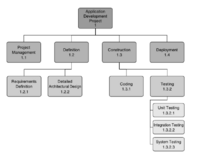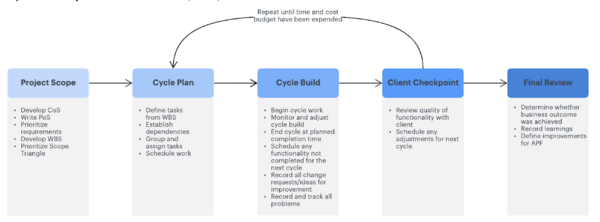Adaptive Project Framework
(→Benefits of APF) |
(→Benefits of APF) |
||
| Line 37: | Line 37: | ||
[[File:Adaptive-project-framework-overview.png|center|600px|thumb|Figure 2: The five steps of APF]] | [[File:Adaptive-project-framework-overview.png|center|600px|thumb|Figure 2: The five steps of APF]] | ||
| − | =Benefits | + | =Benefits= |
'''Finish Sooner''' | '''Finish Sooner''' | ||
APF brings a lot of business value to the table as compared to other approaches. | APF brings a lot of business value to the table as compared to other approaches. | ||
Revision as of 14:48, 20 February 2021
Draft
Adaptive Project Framework (APF) is used in project management and is part of the group of agile methodologies. In so-called traditional project management, managers often approach investment projects as if surroundings and conditions behave in a stable way. However in modern society the volatility and the uncertainty need also to be taken into consideration in its business sector. Therefor traditional project management often does not work in new, difficult economy conditions, especially in software development. At the beginning of 21-century agile project management became widespread in science and practice. However solving the dilemmas of developing project with both agile and traditional project management became difficult and adaptive approach was invented to take advantage of and eliminating the disadvantages of both approaches mentioned above. Therefore the goal of this article is to present the advantages and disadvantages of the adaptive project framework approach. [1]
Contents |
Overview
Recognised strategic leader in the field of project management, Robert K. Wysocki published the book Adaptive Project Framework in 2010, where he describes the APF approach when managing complexity in uncertainty. The AFP method was created to help teams adapt continuously to projects changing environment. This is a systematic and structured process that allows project managers to enhance their decisions and practices during the project life cycle based on learning from previous results achieved during the project. PF is designed to continually adapt to the changing situation of a project from its very beginning to its very end. Therefore, with this approach, nothing is fixed: neither the duration of the project, nor the budget, nor the risks, and everything can be continuously adjusted according to changes in the project's characteristics.[2]
To implement the APF methodology successfully, project teams must be willing to accept and adapt to changes. It is a costumer driven process, where the client is involved in every stage of the process and even given the opportunity to control the direction of the project. Consequently requires the project team to be effectively involved, acting with an open mind and trusting partnership.[3]
The APF project team is combined of client team and development team. Depending of the size of the project the client team can be a single person or multiple. In the client team there needs to be a single member in charge of the decision making, serving as a co-manager along with the development team leader. The development team is composed of technical professionals who are responsible for developing the project and producing the deliverables.[4]
The first step of APF from a traditional mindset is a project scope is a varibale. APF maximises business value by adjusting the scope of the solution as part of each completed cycle. It does this by making the client the central figure in deciding what constitutes maximum business value and putting the client in charge of deciding what changes should be made. At the completion of a cycle, the client has an opportunity to change the direction of the project based on the cumulative learning from all previous cycles. This means that an APF project’s course is constantly corrected to ensure the delivery of maximum business value. the completion of the final cycle, when time or money or both have been used up, the deliverable will have the most business value that could have been produced from the collective wisdom and learning of the client team and the development team
Because scope is variable, APF project planning takes on a whole new meaning. The basic concept underlying an APF project is not to plan the future. The future is unknown. In APF, planning at the micro level is done within each cycle. It begins with a mid-level component- or function-based RBS, and ends with a micro-level activity- and task-based WBS. I like to think of it as just-in-time planning. , where each cycle includes work that will require only a few weeks to complete
Application
Taking a closer look at the project framework, it is a five-phase strategy designed to provide clients with optimum business value from any cycle within the limits of time and cost constraints imposed by the client.
Project Scope
The first part of the process is identifying the project scope and that involves understanding the needs of the costumer. Therefore Stakeholders first step is to determine the Conditions of Satisfaction (CoS). That is the project goals and the desired outcome, by finding out what are the client's needs and how to meet those needs. From this point the Project Overview Statement (POS) is written to outline the CoS and is approved by all stakeholders, this is done to evaluate the effectiveness of the process and how it will be accomplished.[3]
Finally three documents are needed to finish the project scope. First, there is the Functional Requirements, that prioritises actions as well as possible risks, challenges and assumptions. As the project progresses, this may change. Second, there is the Work Breakdown Structure (WBS) that enables teams to estimate costs, develop schedule and break down the processes into manageable parts that need to be accomplished. Finally there is the triangle scope, which is how time, cost and quality will converge.[5]
Cycle plan
The project is divided into multiple mini-projects or cycles, where each cycle delivers one or more deliverables. This is the iterative part of the method, that is repeated over and over again for the next three steps. The cycle plan involves defining each task that needs to be accomplished in each project cycle according to the WBS but is adapted between cycles. Order of the tasks is established, their interdependencies are identified and assigned to employees with an given deadline.[2]
Cycle completion
Cycles can be changed as the team works on the project. The cycle finishes when the pre-defined time elapses, and all the tasks that were not done during this cycle transfer to the next. Ensuring consistent contact, noting any demands for change and new ideas for improvement is critical. They should also be discussed in the next cycle when the team encounters some problematic situations.[3]
Client checkpoint
The Client review is an important step of the process, this is were the client will review the accomplished deliverables during this cycle and evaluate the quality. Together with the project manager a plan will be conducted on any corrections or improvements to be made for the next cycle. Once the review is done then steps 2, 3 and 4 are iterated until the project is complete or until the time and budget has been exhausted.[5]
Post-version review
Completion of the project, the project manager, client and the team will come to together and evaluate the success of the project and determine whether project goals have been accomplished and that the client is pleased. Document of the whole process is done to reflect the effectiveness of the method, lesson learned and possible improvements for future projects.[2]
Benefits
Finish Sooner APF brings a lot of business value to the table as compared to other approaches. APF project finish sooner than TPM projects. The reason for this is obvious. Because APF squeezes out all non-value-added work, it produces less to do than those projects that follow more-traditional approaches. The time spent planning is a good example. Linear and Incremental models plan the entire project, and then when change comes along and is approved, the plan has to be redone from the point of the change to the end of the project. That situation is repeated several times throughout a project, making much of the original planning into non-value-added work. The more changes that are approved, the more non-value-added work there will be. APF has none of this excess baggage, and is therefore guaranteed to finish sooner than traditional approaches.
Less Expensive Non-value-added work costs money. There is at least a labor cost for the time spent planning activities and tasks that are never done due to frequent scope changes. This wastes money in the end
Better Business Termination Policy APF delivers early and often. If anything is going awry, it will be discovered earlier than in a TPM project, giving the project comanagers information on which to decide to terminate the project before any additional time or money is spent needlessly. Some other approach using APF is needed, and the time and money saved by this early termination will be invested in the new direction.
Produces Higher-quality Deliverables The elevated level of client involvement in an APF project means that the client will have a look at intermediate deliverables early in the project and have an opportunity to adjust them. The quality of the final product will therefore exceed
Delivers Maximum Business Value for the Time and Cost Invested
The continual adjustment and redirection of an APF project means everything that is delivered is needed and is of the quality expected by the client. The client, in collaboration with you, decides what goes into the solution at every iteration. Poorer-than-expected deliverables will not survive the APF project life cycle. If an APF project is terminated, at least you will have a partial solution with some business value.
Limitations & Challenges
Agile methodologies complete projects using small releases to produce non-reusable components and these methodologies also focus on small teams because of the characteristics of face-to-face informal communication and cooperation. When a team is large, face-to-face communication becomes notably difficult, and more documentation is required, which is a deviation from the agile spirit. Meanwhile, agile methodologies characterize teams to be self-organizing according to the changing environment, which is mainly feasible for small teams and it does not work for larger teams, where more time is required to self-organize according to a change. The support for large and complex software projects is also limited in agile development assuming that refactoring will purify the code. the agile spirit holds true for small projects but becomes notably difficult in large and complex projects. agile methodologies cannot handle large projects because of the difficulty in tracking the system development life cycle (SDLC) phases of the project.
Conclusion
Adaptive Project Framework is a very effective method that enables teams to forget about the limitations of traditional project management approaches. Similarly to the traditional models, APF also includes scoping and planning phases. However, an adaptive framework allows for effective collaboration between teams and stakeholders. This way, they can adapt the project to the changing environment and quickly react to unforeseen challenges. APF is a flexible approach. When used correctly, it can also help companies minimise expenses and maximise the value proposition. Nevertheless, you should keep in mind that every project is unique, and APF cannot be called a universal approach that will fit projects of all kinds. With that said, if you’re looking for flexibility, APF is certainly the right choice.
Annotated Bibliography
http://j.mecs-press.net/ijmecs/ijmecs-v9-n1/IJMECS-V9-N1-6.pdf
References
- ↑ j. Szreder, P. Walentynowicz and P. Sycz (2019) Adaptive project framework as a development project management method on the example of the Kashubska Ostoja project. Available at: http://j.mecs-press.net/ijmecs/ijmecs-v9-n1/IJMECS-V9-N1-6.pdf .
- ↑ 2.0 2.1 2.2 David Galiana (2020) Adaptive Project Framework: an introductory guide for beginners. Available at: https://www.wimi-teamwork.com/blog/adaptive-project-framework-introductory-guide-beginners/ .
- ↑ 3.0 3.1 3.2 Frank Hamilton (2021) Adaptive Project Framework: How to Implement It. Available at: https://www.startupvalley.news/adaptive-project-framework/ .
- ↑ Robert K. Wysocki Ph.D. (2010) Adaptive Project Framework. Managing Complexity in the Face of Uncertainty. Available at: https://books.google.dk/books?hl=en&lr=&id=M6GDUXXOtxsC&oi=fnd&pg=PT15&dq=adaptive+project+framework&ots=yEHeTTRqmv&sig=Jl-nX12tB_o8DMn-vYijB6R9uio&redir_esc=y#v=onepage&q=adaptive%20project%20framework&f=false .
- ↑ 5.0 5.1 ThinkTheme (n.d.) Adaptive Project Framework Methodology. Available at: https://thinkthyme.com/project-management/adaptive-project-framework-methodology .

